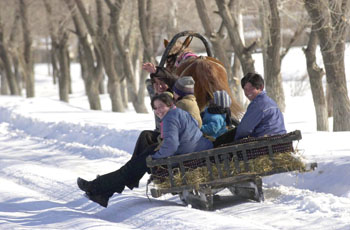Q: Developing rural education and reducing illiteracy
have long been common problems faced by developing countries. There
are many clever children in rural areas in China, but some of them
have dropped out of school because of poverty or for other reasons.
They can't get a good education. What are the Chinese Government's
considerations in improving the school conditions of rural areas
and enhancing the level of rural education? What can be done to
help children who have left school?
A: What you ask concerns us most and is the area toward which
China is devoting the most effort. Since China adopted the policy
of reform and opening up in 1978, rural education has witnessed
great development. By the year 2000, China had basically realized
the goal of popularizing the nine-year compulsory education system,
and reached an average of eight per-capita education years,
exceeding the world average.
Despite these achievements, rural education in China is still
generally weak. There are 431 counties throughout the country that
haven't popularized the nine-year compulsory education system. In
some rural places where compulsory education has been instituted,
the level of education is still low and the foundation unstable.
Problems such as students dropping out of school because of
poverty, defaults in the payment of teachers, and ramshackle
schoolhouses that have fallen into disrepair over the years still
exist in quite a number of places.
The salient problems in rural education have commanded
widespread attention from all of Chinese society. China held the
first National Conference on Rural Education in September 2003,
specially discussing the educational problems in rural areas. At
the conference, it was decided that by 2007, the coverage rate of
the nine-year compulsory education system in China's western region
would increase to at least 85 percent, and the illiteracy rate of
people between the ages of 15 and 50 would be lower than 5
percent
To achieve these goals, the state has greatly increased its
investment in rural compulsory education. In 1997, the financing of
rural compulsory education was 43 billion yuan (US$5.2 billion),
accounting for 54.8 percent of the total investment in compulsory
education that year. In 2003, the central financial allocation to
rural compulsory education reached 109.4 billion yuan (US$13.23
billion), comprising 80 percent of the total funds for compulsory
education that year. The situation of "rural education run by
farmers" has basically been changed to “rural education run by the
government.”
To enable more children who have left school due to poverty to
continue their studies, the central finance allocated in 2004 more
than 10 billion yuan (US$1.21 billion) for special funds. As a
result, 24 million rural students from poor families who were at
the stage of compulsory education got free textbooks. The same
year, the Central Government also allocated 6.8 billion yuan
(US$822.25 million) of educational funds for the western region,
with which 8,130 ramshackle school buildings were rebuilt and 2,364
boarding schools in rural areas were put under construction. In
2005, China will increase its financial commitments to help more
students from rural, poverty-stricken families get an education.
Poor students from 592 poverty-stricken counties will be provided
with free textbooks, exempted from tuition fees and extra fees, and
also given a living allowance. By 2007, about 30 million students
from poverty-stricken families in rural areas will be totally
exempt from tuition fees and extra fees, including textbook fees,
and boarders will be provided with a living allowance.
 |
Several Kazak children go to school by a
snow sledge in Xinjiang Uygur Autonomous Region.